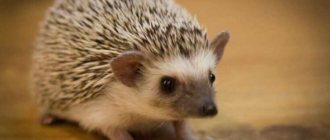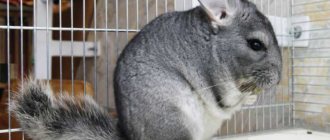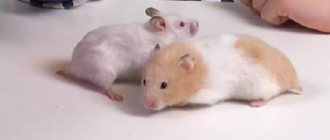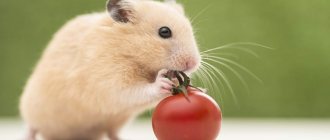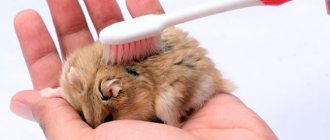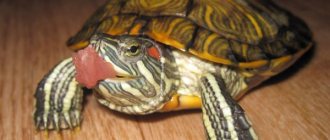Having made a deliberate decision to get a hamster at home, you must first make sure that your household members are not allergic to animal fur, choose the right place of residence for the future pet and study the rules for caring for it.
The hamster is a rather picky animal, but still requires careful care and attentive attitude towards itself.
Pros and cons of keeping a hamster at home
Before you get a pet hamster, you need to familiarize yourself with its main characteristics.
A convenient feature of this animal is that it is kept without a similar individual, that is, the hamster does not have to have a mate. He feels great alone, unless, of course, you are going to start breeding them.
The benefits of breeding a hamster at home are:
- small fluid intake, in case of taking juicy foods;
- keep the room quiet;
- the main difference from cats and dogs is the absence of rancor and resentment;
- have a positive attitude towards children;
- occupy a fairly small area;
- easy to train;
- breed in captivity;
- unpretentious in eating.
- in winter, the hamster can hibernate, and when it wakes up, it requires more food;
- constant care of the cage in which the animal is kept is necessary;
- It is necessary to keep a hamster only in a terrarium, otherwise it can ruin things;
- a hamster can be aggressive towards people.
Animal color
The common hamster, whose photos are often distributed throughout the Internet, has a rather attractive appearance. Bright colors predominate on the body. The back and sides of the animal are predominantly red. The abdomen and chest are black. The nose and paws are almost always white. And on the chest at the side of the head there are often 3 white spots. In general, color depends on where you live. Sometimes you can find a rodent that is completely black or black and white in color. Such a beautiful appearance thanks to people is the main problem of the animal. Many people hunt him for his skin. Often even specially trained dogs enter.
Keeping a hamster at home
Before getting a hamster, you need to carefully consider its habitat in the premises. A glass jar, aquarium or box will bring discomfort to the little resident.
For these purposes, it is wise to purchase a spacious iron cage (50 by 30 centimeters) with horizontal bars, the distance between which is not too wide so that the animal cannot get out of its home.
The resident needs to select additional special accessories for their new home:
- The bottom of the house must be filled with filler, which will help avoid unpleasant odors. It needs to be changed regularly, washing the cage thoroughly. The filler comes in pressed form and in granules. It is also wise to sprinkle some sawdust, which hamsters like to burrow into before going to bed.
- You need to place a couple of feeders in the cage: for natural food and for dry food.
- It is wise to hang a special drinking bowl for small animals on the bars of the house, the water from which will not flow out on its own.
- A running wheel will help an active animal spend time without being bored.
- To periodically sharpen sharp teeth, a mineral pebble is placed in the cage.
- The pet will choose the corner for the toilet itself; the toilet must be regularly replaced with fresh flooring.
Pet hamster diet
If you still decide to get a pet, you need to know what a hamster eats several times a day. Since this animal is active at night, select the most high-calorie foods for its evening meal. To avoid poisoning, do not feed him excessively watery food (watermelon, melon, cucumber, etc.).
Approximately once a day you need to give your pet a special food made from a mixture of grains, the range of which is offered by specialized pet stores for animals.
The hamster usually determines the norm for one meal without anyone's help, but food must be constantly present, as well as the presence of fresh water. Don't forget to make sure your pet drinks enough throughout the day, this is a vital condition for hamsters!
Approximate diet for a domestic hamster:
- Vegetables and fruits, pitted.
- Potato.
- Grain mixture.
- Lean cooked meat.
- Seeds and nuts in small portions.
- Vitamin complex.
It is highly undesirable to feed your animal garlic and onions, citrus fruits and tropical foods.
Life style of an ordinary animal
The common hamster (Cricetus Cricetus) leads a fairly varied lifestyle. Its lifespan of 8 years allows it to live 2-3 times longer than its domestic counterparts. Thanks to its agility, activity and, of course, claws, the animal digs holes up to 8 meters. And this is not just a pit, it is a network of tunnels that have different chambers and serve for various purposes. There can be up to 10 exits from the hole itself, from this you can see how careful the hamster is. Leaves many escape routes in case of danger.
From August he begins to actively work on food and replenish supplies for the winter. One or more chambers in the burrow serve as a storage room where all collected food is stored. At such a depth, predators cannot reach it. Even severe frosts are not able to reach the hamster and its supplies. And he lives very well in the hole; there is always bedding, which he makes for himself to make it warmer. The depth of the hole rarely exceeds 2.5 meters. With the onset of winter, the common hamster goes into hibernation. From time to time he wakes up for a meal, it’s not in vain that so much time and effort was spent collecting such treasures.
Like other species, our hero is a loner and does not allow competitors into his territory. When uninvited guests invade, there will definitely be a fight between the hamsters (unless, of course, the enemy immediately leaves). Someone must retreat or die. Two hamsters do not get along in the same territory. During the breeding season, they come together only to mate, after which they again live a solitary life. The animal can attack not only its fellow animals, but also a person. An interesting fact about the hamster is that it is not afraid of larger opponents. Therefore, he is able to bite people and fight back. But there is also control over it; a rodent can become prey for a fox or ferret.
When the animal is ready to attack, it stands like a man on two hind legs , with the front legs at chest level and slightly spread to the sides. At this time, he can jump into the attack, which he usually does. But after the jump, he returns to his stance to prepare for the next attack. Despite the fact that the animal runs and jumps quickly, in a calm state it moves rather slowly. Photos of the common hamster during the daytime are posted on the Internet, but these are rather exceptions, since these are nocturnal animals and they sleep during the day.
Photos of hamsters
Cow - description of appearance, diet, breed, interesting information + 109 photosChinchilla - breed classifications, fur features, care rules, nutrition and bathing + 94 photos

